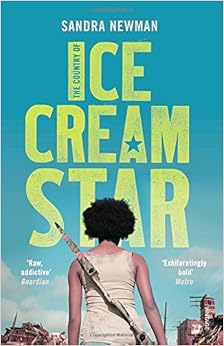The Country of Ice Cream Star

“We flee like a dragonfly over water, we fight like ten guns, and we be bell to see. Other children go deranged and unpredictable for our love.”
Longlisted for the 2015 Baileys’ Prize for Women’s Fiction, this is the third novel by Sandra Newman, who is American-born but resides in England. It may have missed out on the grander aspirations of the shortlist, but this book is still very much worthy of consideration as a summer read.
Ice Cream Fifteen Star, to credit her full title, is the protagonist through whose eyes the story unfolds. She is a “Sengle”, the term given to members of her hunter-gatherer tribe who survive by scavenging in abandoned houses or tracking wild animals with bows and arrows in a post-apocalyptic “Nighted States”. Her brother, Driver Eighteen, leads their tribe, but he is hiding the early stages of “posies” – a vicious and ugly disease that kills everyone around the age of twenty, and from which there is no escape. This explains the importance of having people’s ages exposed within their names; as soon as one is “gone in posy sickness” one is as good as dead, and shunned abruptly from society to pass away in “useless silence”.
Ice Cream’s chief concern at first is that, when Driver does succumb to his affliction, Crow Sixteen will become the new “sergeant” – Ice Cream’s erstwhile “animose” (close friend), Crow has in recent years become cold and unkind to her. Matters are complicated further when the tribe capture one of the semi-mythical “roo” creatures; tall, burly, and fair-skinned, unlike the Sengles’ “tarry night sort”, they seem to live far beyond twenty years without signs of posies. Believing that this roo, Pasha, may hold the key to saving her brother and her people at large, Ice Cream and her headstrong compatriot, Keepers Eight, forge a wary relationship with him, whilst keeping the many other Sengles who would not hesitate to kill the foreigner from doing just that.
In case it were not apparent already, the defining feature of this book is its thoroughly distinctive language. Grammatically, it is akin to the speech of the Big Isle tribesmen in Cloud Atlas, whilst the invented areas of vocabulary appear stitched together from various Indo-European roots, in the vein of the Nadsat dialect in A Clockwork Orange. This example comes from the first chapter, as Ice Cream relays the events of one of their forages:
Ya, this been a feary day, because we find a sleeper house. Been two sleepers there, they lain together in a bed. One been grown, one eightish size. Both gone with years to stain and bones. Skeletons mix their ribs, their ghosty hair caught in one tangle.
As with any vernacular text, it is not necessary to understand every word immediately in order to follow the essence of the plot. Moreover, though this contrived style takes a few pages to settle into, the reader’s patience will be rewarded with some astonishingly beautiful and fertile turns of phrase. Trees in the evening sunlight “glamour white like patches of moon”; the roo is “a marvel in his bluish gaze and catly hair”; a moment of passion Ice Cream shares with another character is “dizziness and sparks […] slow and feroce, this kiss contain all feary luxury”; and a personal favourite – “Radio voice been like the voice of flies when your best child is dead”.
As the book progresses, it opens out and branches into myriad new locations and peoples for Ice Cream to meet and understand, love, fight or flee – from forging trade deals with El Mayor of the industrious Lowell people, to maintaining a truce with the fearful Nat Mass Army, and seeking assistance from the goodly Christings. Ice Cream Star is a worthy prize nominee: a horror story veiled in exquisite prose.
Adam Learmonth

Leave a Reply